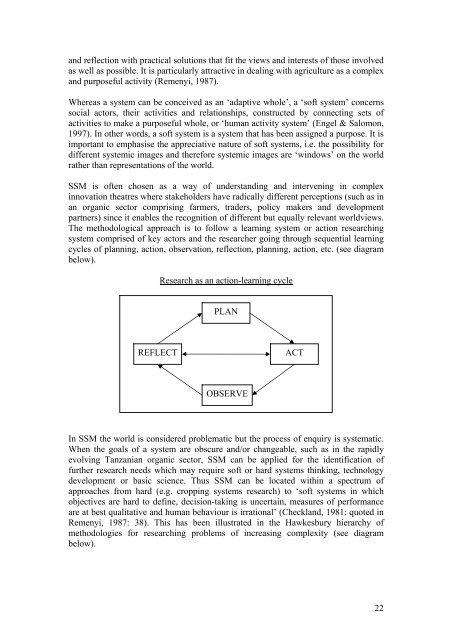Sustaining Livelihoods through Organic Agriculture in Tanzania - UMB
Sustaining Livelihoods through Organic Agriculture in Tanzania - UMB
Sustaining Livelihoods through Organic Agriculture in Tanzania - UMB
Create successful ePaper yourself
Turn your PDF publications into a flip-book with our unique Google optimized e-Paper software.
and reflection with practical solutions that fit the views and <strong>in</strong>terests of those <strong>in</strong>volved<br />
as well as possible. It is particularly attractive <strong>in</strong> deal<strong>in</strong>g with agriculture as a complex<br />
and purposeful activity (Remenyi, 1987).<br />
Whereas a system can be conceived as an ‘adaptive whole’, a ‘soft system’ concerns<br />
social actors, their activities and relationships, constructed by connect<strong>in</strong>g sets of<br />
activities to make a purposeful whole, or ‘human activity system’ (Engel & Salomon,<br />
1997). In other words, a soft system is a system that has been assigned a purpose. It is<br />
important to emphasise the appreciative nature of soft systems, i.e. the possibility for<br />
different systemic images and therefore systemic images are ‘w<strong>in</strong>dows’ on the world<br />
rather than representations of the world.<br />
SSM is often chosen as a way of understand<strong>in</strong>g and <strong>in</strong>terven<strong>in</strong>g <strong>in</strong> complex<br />
<strong>in</strong>novation theatres where stakeholders have radically different perceptions (such as <strong>in</strong><br />
an organic sector compris<strong>in</strong>g farmers, traders, policy makers and development<br />
partners) s<strong>in</strong>ce it enables the recognition of different but equally relevant worldviews.<br />
The methodological approach is to follow a learn<strong>in</strong>g system or action research<strong>in</strong>g<br />
system comprised of key actors and the researcher go<strong>in</strong>g <strong>through</strong> sequential learn<strong>in</strong>g<br />
cycles of plann<strong>in</strong>g, action, observation, reflection, plann<strong>in</strong>g, action, etc. (see diagram<br />
below).<br />
REFLECT<br />
Research as an action-learn<strong>in</strong>g cycle<br />
PLAN<br />
OBSERVE<br />
ACT<br />
In SSM the world is considered problematic but the process of enquiry is systematic.<br />
When the goals of a system are obscure and/or changeable, such as <strong>in</strong> the rapidly<br />
evolv<strong>in</strong>g <strong>Tanzania</strong>n organic sector, SSM can be applied for the identification of<br />
further research needs which may require soft or hard systems th<strong>in</strong>k<strong>in</strong>g, technology<br />
development or basic science. Thus SSM can be located with<strong>in</strong> a spectrum of<br />
approaches from hard (e.g. cropp<strong>in</strong>g systems research) to ‘soft systems <strong>in</strong> which<br />
objectives are hard to def<strong>in</strong>e, decision-tak<strong>in</strong>g is uncerta<strong>in</strong>, measures of performance<br />
are at best qualitative and human behaviour is irrational’ (Checkland, 1981: quoted <strong>in</strong><br />
Remenyi, 1987: 38). This has been illustrated <strong>in</strong> the Hawkesbury hierarchy of<br />
methodologies for research<strong>in</strong>g problems of <strong>in</strong>creas<strong>in</strong>g complexity (see diagram<br />
below).<br />
22

















